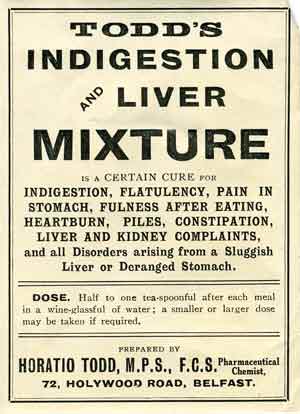TEA MANIA
Published in Features, Issue 4 (July/August 2022), Volume 30By Ian Miller
In 1872, an alarmed lady wrote to the Freeman’s Journal to report that:
‘Taking shelter in a cottage, near Banbridge, County Down, some time ago, during a shower of rain, and noticing the teapot on the hob, I observed that tea stewed in that way did a great deal of harm. The woman who lived in the cottage at once admitted that the parish doctor had said, “the folks were killing themselves with tea”, and that it caused him more trouble than anything else. A few days ago a gentleman, just come up to town, was mentioning that the poor people in his neighbourhood suffered dreadfully from “tic”. I replied that this was a disease often caused, I believed, by excessive tea-drinking. “Indeed”, he answered; “well I must say, they do take immense quantities of tea”.’
In the 1870s deep economic depression set in, causing widespread poverty and distress across Ireland. Although relatively shielded by its industrial success, economic decline threatened to worsen Belfast’s health problems, placing demands on budgeting, nutritional health and the basic ability to purchase food. Until well into the twentieth century diet and nutrition caused major concern. Even in the wealthier heyday of the 1860s, local physician Henry MacCormac had commented on how the city’s working classes were jettisoning nutritious diets of potatoes, wheatmeal bread, stews and milk for meagre servings of tea and white bread. As the Freeman’s Journal letter suggests, discussion of working-class nutrition coalesced around a particular problem: excessive tea-drinking.
NO LONGER A LUXURY ITEM
Tea had once been a luxury item enjoyed mainly by the middle classes. From around the 1850s the cost of tea lowered significantly, largely owing to imperial investment in India’s tea trade. Consumption levels increased rapidly in post-Famine Ireland. In Belfast this was accompanied by the expansion of large city bakeries, which produced cheap but less nutritious white bread. In 1868 one physician, John Moore, complained of mill workers consuming a substance
‘… which can hardly be called tea, infused frequently from the evening before, allowed to remain all night in metallic vessels, warmed up again not only for breakfast but for the mid-day meal, it becomes at last to resemble tobacco water more than anything else.’
With much disappointment, almost 40 years later, the Belfast Health Commission (1907) reported on mill workers still contenting themselves only with tea, bread and butter, even in the York Street Spinning Company, which had a canteen serving wholesome, nourishing food. By then, medical concern had turned towards the strength of the workers’ tea rather than its watery weakness. Working-class families left tea stewing on the stove all day long, producing a strong, thick substance containing high tannic acid levels. In 1892 the British Medical Journal warned that ‘indigestion is unknown among tea drinkers in the East and it is, in all probability, only the result of our defective use of the leaf’. Thein (or caffeine) was also described as potentially addictive.
‘TEA DRUNKARDS’
Victorian psychiatrists believed that women’s supposedly delicate, emotional nature made them susceptible to ‘insanity’. Tea-drinking was not considered a direct cause of mental health problems, but the chronic dyspepsia brought on by the stomach’s ‘nervous excitement’ affected mental functioning, paving the way for psychiatric issues. In the 1890s some psychiatrists invented new terms, including ‘tea drunkards’ and ‘tea mania’, a condition with the following symptoms: headache, vertigo, insomnia, heart palpitations, mental confusion, nightmare, nausea, hallucinations, morbid depression of spirits and suicidal feelings.
In 1872 the Freeman’s Journal reported on a 32-year-old domestic servant who, despite having enjoyed good health in the past, had ‘got into a state of great weakness’ and was suffering from laughing and crying fits. She tried to conceal her problems by working as usual, but one day, while cleaning a grate, she collapsed speechless and senseless and had several hysterical fits. Medical examination revealed that she had become hopelessly addicted to tea, now caring for little else in life other than her favourite drink.
Concern peaked in the 1890s when Dublin Castle initiated an official investigation into rising asylum admissions. At the time, emigration was causing a rapid population decline in Ireland. This made the problem of rising asylum admissions seem all the more curious, as asylum populations should surely also have been declining proportionately. Lunacy inspectors George Plunkett O’Farrell and E. Maziere Courtenay blamed rising admissions on the inability of many families to purchase nutritious food. O’Farrell and Courtenay believed that this, combined with the mental anxiety of economic downturn, produced the ‘insanity of malnutrition’. Across the island, almost all asylum superintendents blamed poor nutrition, and specifically over-reliance on tea, for rising admissions. Prominent psychiatrist Thomas Drapes wrote that ‘we see [tea’s] effects in the number of pale-faced children, who are brought up on it instead of the old time-honoured, but now nearly abandoned, porridge and milk’. Commenting on Belfast, O’Farrell and Courtenay acknowledged that the city’s population had expanded, unlike most other Irish regions, but still singled out problems such as ‘alcoholic excess’, ‘insufficient or unsuitable dietary, especially amongst factory workers’, and ‘the excessive consumption of tea; not the ordinary infusion, but a decoction of it, now so common among the working classes’.

Above: Gummed label for ‘Todd’s Indigestion and Liver Mixture’, prepared by Horatio Todd, Belfast. Late Victorian doctors believed that excessive tea-drinking caused chronic indigestion (or dyspepsia), which gradually took its toll on mental health. (National Museums NI)
TEA AND IMMORALITY
Doctors discussed excessive tea-drinking as a problem of both health and morals. The Temperance movement had campaigned successfully against the consumption of alcoholic spirits, particularly in the North. Doctors now feared that tea—long lauded as an alternative to alcohol—could be just as pernicious. They viewed tea as a nervous stimulant. When consumed excessively, it caused mental excitability and over-stimulation. Doctors criticised poor women for using tea like a drug, prioritising mental exhilaration and sensory stimulation above nutrition. They accused working-class women of lacking knowledge of correct tea preparation and, in consequence, recklessly succumbing to addiction. In contrast, the civilised middle classes trusted themselves to drink moderately and sensibly in polite settings such as tea parties.
‘Tea and coffee’, warned the Belfast News-Letter in 1887, ‘offer the opportunity for abuse—an opportunity quite often availed of. Their devotees drink for the mere love of them, more than they ought.’ The article continued by (melodramatically) describing hospital waiting rooms filled with dyspeptics suffering the consequences of their tea addiction. It then outlined a cycle of events involving a tea-obsessed housewife who gradually lost her appetite, slowly came to loathe food and eventually sought solace in the teacup. Once hooked, she adopted tea preparation methods designed to secure as much tannin as possible (e.g. stewing) to quell her ever-intensifying cravings. The News-Letter insisted that addicted women had chosen to ‘wilfully forsake good food for tea’. Similarly, Royal Victoria Hospital doctor John Alexander Lindsay complained to the Belfast Natural History and Philosophical Society in 1882 that the national physique was deteriorating because the working classes had decadently substituted milk for tea.
WORKING-CLASS REALITIES
These perspectives failed to acknowledge that milk was often adulterated, watered down, infected with tuberculosis or simply too costly. In reality, tea consumption was often a necessity, not a choice. The moralising attitudes of doctors failed to grasp bleak working-class realities. In times of need, working-class mothers made hard decisions to go without and economise by serving nutritious food to other household members. Fathers needed strength for the workplace, the young to ensure healthy physical growth. Mothers sacrificed their own health, using tea to suppress appetite and quell hunger pangs. They were not recklessly seeking hedonistic pleasure but instead navigating what today we call food poverty.
In 1893 Francis Hope claimed that Belfast’s residents had consumed five million pounds of tea that year. Hope wrote: ‘As one passes through the squalid streets where the poor live, and views the abject poverty, the real suffering from want, the dirt and degradation, the sight is overwhelming. One’s heart is wrung for the misery of these poor souls.’ He proposed a simple solution: ‘Practice a little self-denial’. ‘Poor souls! They perish for lack of knowledge’, continued the author. In reality, no amount of savings made from abstaining from tea could ever hope to overcome socio-economic problems such as lack of money, low wages, poor housing and persistent public health problems.
Ian Miller lectures in Medical History at Ulster University and is one of the contributors to the Epidemic Belfast website, epidemic-belfast.com, from which this article is drawn.
Further reading
L.A. Clarkson & E.M. Crawford, Feast and famine: a history of food and nutrition in Ireland, 1500–1920 (Oxford, 2001).
T. Cusack, ‘“This pernicious tea drinking habit”: women, tea and respectability in nineteenth-century Ireland’, Canadian Journal of Irish Studies 41 (2018), 178–209.
I. Miller, ‘“A dangerous revolutionary force amongst us”: conceptualising working-class tea drinking in the British Isles, c. 1860–1900’, Cultural and Social History 10 (3) (2013), 419–38.
I. Miller, Reforming food in post-Famine Ireland: medicine, science and improvement, 1845–1922 (Manchester, 2014).
















